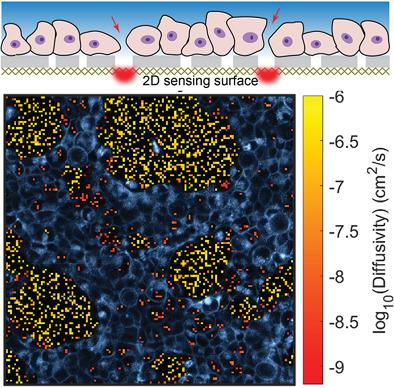当前位置:
X-MOL 学术
›
Adv. Funct. Mater.
›
论文详情
Our official English website, www.x-mol.net, welcomes your
feedback! (Note: you will need to create a separate account there.)
Atomically Thin 2D Interfaces as Sensors for Molecular Permeability through Cellular Layers and Thin Tissues
Advanced Functional Materials ( IF 18.5 ) Pub Date : 2022-01-12 , DOI: 10.1002/adfm.202109598 Volodymyr B. Koman 1 , Xun Gong 1 , Naveed A. Bakh 1 , Kevin Silmore 1 , Daniel P. Salem 1 , Tedrick Thomas Salim Lew 1, 2, 3 , Matthias Kuehne 1 , Daichi Kozawa 1, 4 , Minkyung Park 1 , Michael S. Strano 1
Advanced Functional Materials ( IF 18.5 ) Pub Date : 2022-01-12 , DOI: 10.1002/adfm.202109598 Volodymyr B. Koman 1 , Xun Gong 1 , Naveed A. Bakh 1 , Kevin Silmore 1 , Daniel P. Salem 1 , Tedrick Thomas Salim Lew 1, 2, 3 , Matthias Kuehne 1 , Daichi Kozawa 1, 4 , Minkyung Park 1 , Michael S. Strano 1
Affiliation

|
The permeability of cell layers plays a critical role in the life sciences and medicine. It remains a long-standing challenge to assess molecular transport through cell layers with subcellular spatial resolution. Herein, a novel sensing platform employing atomically thin and photoluminescent MoS2 monolayers as 2D sensing interfaces is developed to detect the diffusion of probe molecules through cellular layers and tissues. The 2D form factor enables monolayer MoS2 to serve as an array of 20 164 optical sensors covering a total area of 420 × 420 µm2, being the only nanosensor interface that can spatially image molecular permeability in this way. In a single layer of human umbilical vein endothelial cells (HUVEC), regions with diffusivities ranging from 1 × 10−9 to 3 × 10−8 cm2 s−1 are found that are in part spatially correlated with the immunofluorescence of vascular endothelial (VE)-cadherin proteins found on the cell membrane. However, the new technique clearly identifies these locations as breaks of nanoscale cellular junctions less than 40 nm in length in intercellular clefts that are otherwise impossible to measure with conventional microscopy. With the ability to measure permeability through various tissues, this 2D sensing interface allows the measurement of biological properties to assist the development of targeted therapeutics and mechanistic models.
中文翻译:

原子级薄二维界面作为通过细胞层和薄组织的分子渗透性传感器
细胞层的渗透性在生命科学和医学中起着至关重要的作用。以亚细胞空间分辨率评估通过细胞层的分子转运仍然是一个长期存在的挑战。在此,开发了一种采用原子级薄和光致发光 MoS 2单层作为二维传感界面的新型传感平台,以检测探针分子通过细胞层和组织的扩散。2D 形状因子使单层 MoS 2能够作为 20 164 个光学传感器阵列,覆盖总面积为 420 × 420 µm 2,是唯一可以以这种方式对分子渗透率进行空间成像的纳米传感器接口。在单层人脐静脉内皮细胞 (HUVEC) 中,扩散率范围为 1 × 10-9至 3 × 10 -8 cm 2 s -1被发现在空间上与细胞膜上发现的血管内皮 (VE)-钙粘蛋白的免疫荧光部分相关。然而,新技术清楚地将这些位置识别为细胞间裂缝中长度小于 40 nm 的纳米级细胞连接的断裂,否则这些位置无法用常规显微镜测量。由于能够测量各种组织的渗透性,这种 2D 传感接口允许测量生物特性,以帮助开发靶向治疗和机械模型。
更新日期:2022-01-12
中文翻译:

原子级薄二维界面作为通过细胞层和薄组织的分子渗透性传感器
细胞层的渗透性在生命科学和医学中起着至关重要的作用。以亚细胞空间分辨率评估通过细胞层的分子转运仍然是一个长期存在的挑战。在此,开发了一种采用原子级薄和光致发光 MoS 2单层作为二维传感界面的新型传感平台,以检测探针分子通过细胞层和组织的扩散。2D 形状因子使单层 MoS 2能够作为 20 164 个光学传感器阵列,覆盖总面积为 420 × 420 µm 2,是唯一可以以这种方式对分子渗透率进行空间成像的纳米传感器接口。在单层人脐静脉内皮细胞 (HUVEC) 中,扩散率范围为 1 × 10-9至 3 × 10 -8 cm 2 s -1被发现在空间上与细胞膜上发现的血管内皮 (VE)-钙粘蛋白的免疫荧光部分相关。然而,新技术清楚地将这些位置识别为细胞间裂缝中长度小于 40 nm 的纳米级细胞连接的断裂,否则这些位置无法用常规显微镜测量。由于能够测量各种组织的渗透性,这种 2D 传感接口允许测量生物特性,以帮助开发靶向治疗和机械模型。











































 京公网安备 11010802027423号
京公网安备 11010802027423号